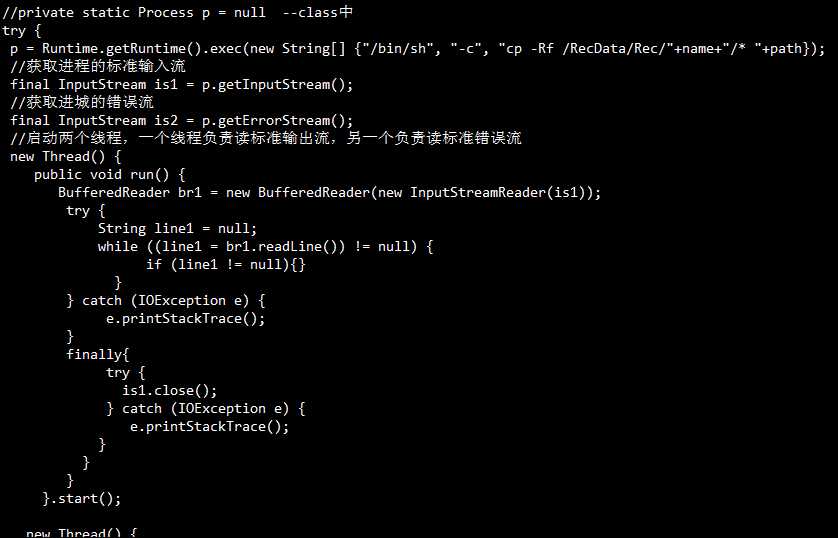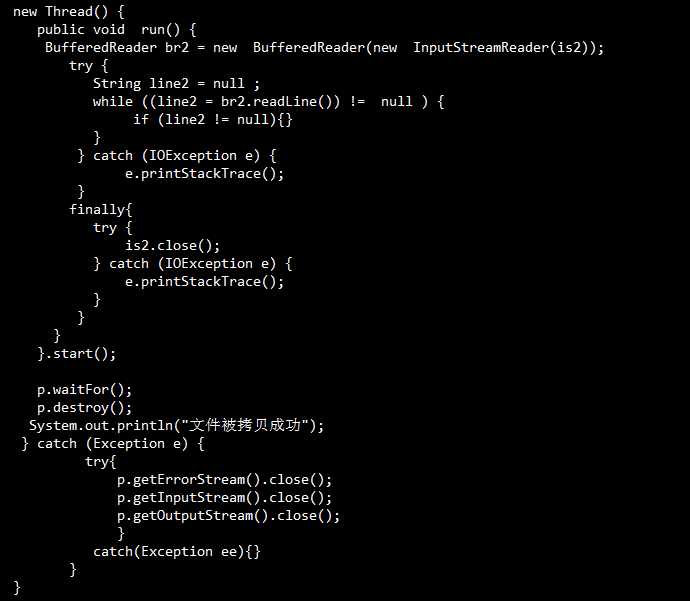标签:钩子 还需 roc include obb 分享 cat buffer trap
Runtime 类代表着Java程序的运行时环境,每个Java程序都有一个Runtime实例,该类会被自动创建,我们可以通过Runtime.getRuntime() 方法来获取当前程序的Runtime实例。
/* * 获取当前jvm的内存信息,返回的值是 字节为单位 * */ public static void getFreeMemory() { //获取可用内存 long value = Runtime.getRuntime().freeMemory(); System.out.println("可用内存为:"+value/1024/1024+"mb"); //获取jvm的总数量,该值会不断的变化 long totalMemory = Runtime.getRuntime().totalMemory(); System.out.println("全部内存为:"+totalMemory/1024/1024+"mb"); //获取jvm 可以最大使用的内存数量,如果没有被限制 返回 Long.MAX_VALUE; long maxMemory = Runtime.getRuntime().maxMemory(); System.out.println("可用最大内存为:"+maxMemory/1024/1024+"mb"); }
一般可以和newFixedThreadPool一起使用
/* * 获取jvm可用的处理器核心的数量 * */ public static void getAvailableProcessors() { int value = Runtime.getRuntime().availableProcessors(); System.out.println(value);
ExecutorService fixedThreadPool = Executors.newFixedThreadPool(Runtime.getRuntime().availableProcessors()); }
public Process exec(String command)-----在单独的进程中执行指定的字符串命令。 public Process exec(String [] cmdArray)---在单独的进程中执行指定命令和变量 public Process exec(String command, String [] envp)----在指定环境的独立进程中执行指定命令和变量 public Process exec(String [] cmdArray, String [] envp)----在指定环境的独立进程中执行指定的命令和变量 public Process exec(String command,String[] envp,File dir)----在有指定环境和工作目录的独立进程中执行指定的字符串命令 public Process exec(String[] cmdarray,String[] envp,File dir)----在指定环境和工作目录的独立进程中执行指定的命令和变量
1.destroy():杀掉子进程
2.exitValue():返回子进程的出口值,值 0 表示正常终止
3.getErrorStream():获取子进程的错误流
4.getInputStream():获取子进程的输入流
5.getOutputStream():获取子进程的输出流
6.waitFor():导致当前线程等待,如有必要,一直要等到由该Process对象表示的进程已经终止。如果已终止该子进程,此方法立即返回。如果没有终止该子进程,调用的线程将被阻塞,直到退出子进程,根据惯例,0 表示正常终止
注意:在java中,调用runtime线程执行脚本是非常消耗资源的,所以切忌不要频繁使用!
在调用runtime去执行脚本的时候,其实就是JVM开了一个子线程去调用JVM所在系统的命令,其中开了三个通道:输入流、输出流、错误流,其中输出流就是子线程走调用的通道。
大家都知道,waitFor是等待子线程执行命令结束后才执行, 但是在runtime中,打开程序的命令如果不关闭,就不算子线程结束。比如以下代码。
private static Process p = null; p = Runtime.getRuntime().exec("notepad.exe"); p.waitFor(); System.out.println("-------------------我被执行了-------------------");
以上代码中,打开windows中记事本。如果我们不手动关闭记事本,那么输出语句就不会被执行,这点是需要理解的。


Runtime.getRuntime().exec("notepad.exe");
Runtime.getRuntime().exec("cmd /c start " + "\"\" \"" + path + "\"");
Runtime.getRuntime().exec("C:\\Program Files\\Internet Explorer\\IEXPLORE.EXE");
@Test public void dirRuntimeProcess() throws IOException, InterruptedException { Process process = Runtime.getRuntime().exec("cmd.exe /c echo %JAVA_HOME%"); BufferedReader bufferedReader = new BufferedReader(new InputStreamReader(process.getInputStream())); String string = null; while ((string = bufferedReader.readLine()) != null) { System.out.println(string); // D:\Java\jdk\jdk1.8.0_152 } process.waitFor(); System.out.println("return: " + process.exitValue()); // return: 0 }
@Test public void getJavaVersion() { try { Process process = Runtime.getRuntime().exec("javac -version"); BufferedReader br = new BufferedReader(new InputStreamReader(process.getErrorStream())); String line = null; while ((line = br.readLine()) != null) System.out.println(line); // javac 1.8.0_152 process.waitFor(); System.out.println("Process exitValue: " + process.exitValue()); } catch (Throwable t) { t.printStackTrace(); } }
@Test public void execProgramC() { try { Process process = Runtime.getRuntime().exec("C:/Users/76801/Desktop/huhx.exe"); BufferedReader br = new BufferedReader(new InputStreamReader(process.getInputStream())); String line = null; while ((line = br.readLine()) != null) System.out.println(line); // Hello World. process.waitFor(); System.out.println("Process exitValue: " + process.exitValue()); } catch (Throwable t) { t.printStackTrace(); } }
huhx.c比较简单,就是打印一句话。
#include<stdio.h> void main() { printf("Hello World."); }
@Test public void execMysqldump() throws IOException, InterruptedException { String execCommand = "cmd c/ D:/Java/mysqldump.exe -uhuhx -phuhx boot_learn > D:/bootlearn.sql"; System.out.println("exec command: " + execCommand); Runtime runtime = Runtime.getRuntime(); Process p = runtime.exec(execCommand); StreamGobbler errorGobbler = new StreamGobbler(p.getErrorStream(), "Error"); StreamGobbler outputGobbler = new StreamGobbler(p.getInputStream(), "Output"); errorGobbler.start(); outputGobbler.start(); p.waitFor(); System.out.println("successful." + p.exitValue()); }
上述也使用到了网上所说的读出窗口的标准输出缓冲区中的内容,仍旧没有解决Process的waitFor阻塞问题。下面是清空缓冲区的线程代码:
public class StreamGobbler extends Thread { InputStream is; String type; public StreamGobbler(InputStream is, String type) { this.is = is; this.type = type; } public void run() { try (InputStreamReader isr = new InputStreamReader(is);) { BufferedReader br = new BufferedReader(isr); String line = null; while ((line = br.readLine()) != null) { if (type.equals("Error")) { System.out.println("Error :" + line); } else { System.out.println("Debug:" + line); } } } catch (IOException e) { e.printStackTrace(); } } }
代码的目标是导出mysql数据库的脚本。没有找到问题的解决方案,运行环境是win10,jdk1.8。
阅读ElasticSearch的源码时,BootStrap类中调用了Runtime.getRuntime().addShutdownHook方法。接下来对java.lang包中的Runtime类的addShutdownHook方法进行说明。
这个方法的意思就是在JVM中增加一个关闭的钩子,当JVM关闭的时候,会执行系统中已经设置的所有通过方法addShutdownHook添加的钩子,当系统执行完这些钩子后,JVM才会关闭。所以这些钩子可以在JVM关闭的时候进行内存清理、对象销毁等操作。
为了更清晰的说明,编写如下程序:
public class TestShutdownHook { public static void main(String[] args) { // thread1 Thread thread1 = new Thread() { public void run() { System.out.println("thread1"); } }; // thread2 Thread thread2 = new Thread() { public void run() { System.out.println("thread2"); } }; // shutdownThread Thread shutdownThread = new Thread() { public void run() { System.out.println("shutdownThread"); } }; Runtime.getRuntime().addShutdownHook(shutdownThread); thread1.start(); thread2.start(); } }
输出结果:
thread1
thread2
shutdownThread
或
thread2
thread1
shutdownThread
无论是先打印thread1还是thread2,shutdownThread 线程都是最后执行的(因为这个线程是在JVM执行关闭前才会执行)。
关闭JVM程序
Runtime的exit表示的关闭JVM程序,但是不释放内存,举例:
System.exit(0);//表示正常程序的关闭,执行的是以下操作: public static void exit(int status) { Runtime.getRuntime().exit(status); }
备注:如果是 0表示正常关闭,如果是非0表示异常关闭,如果想释放内存的话,用“dispose()”关闭当前程序,并释放资源。
System.exit()的内部实现也是Runtime.getRuntime().exit();
标签:钩子 还需 roc include obb 分享 cat buffer trap
原文地址:https://www.cnblogs.com/shamo89/p/9807019.html